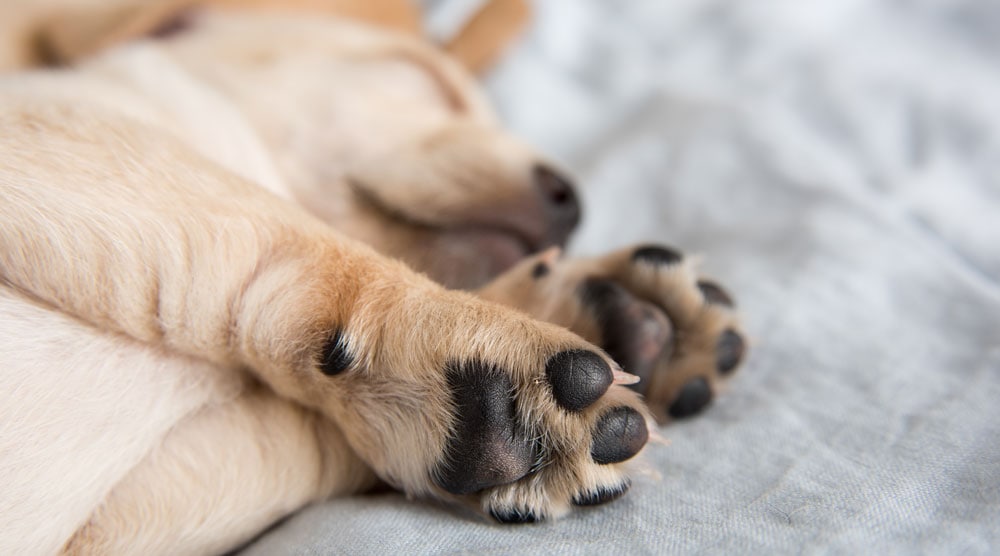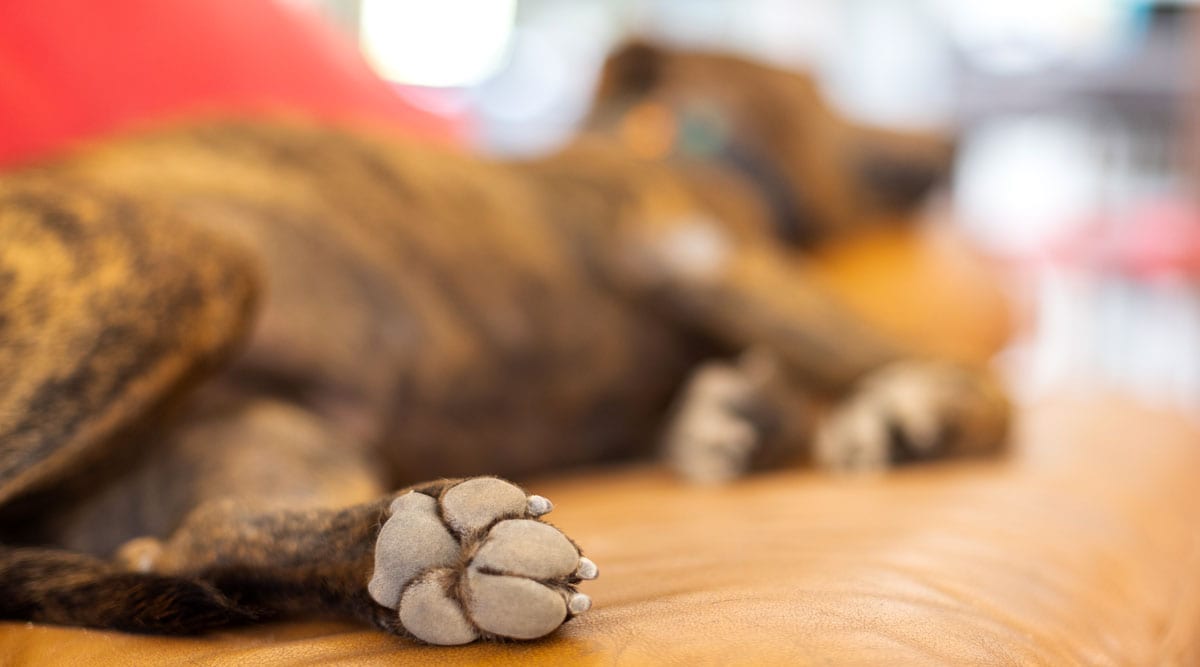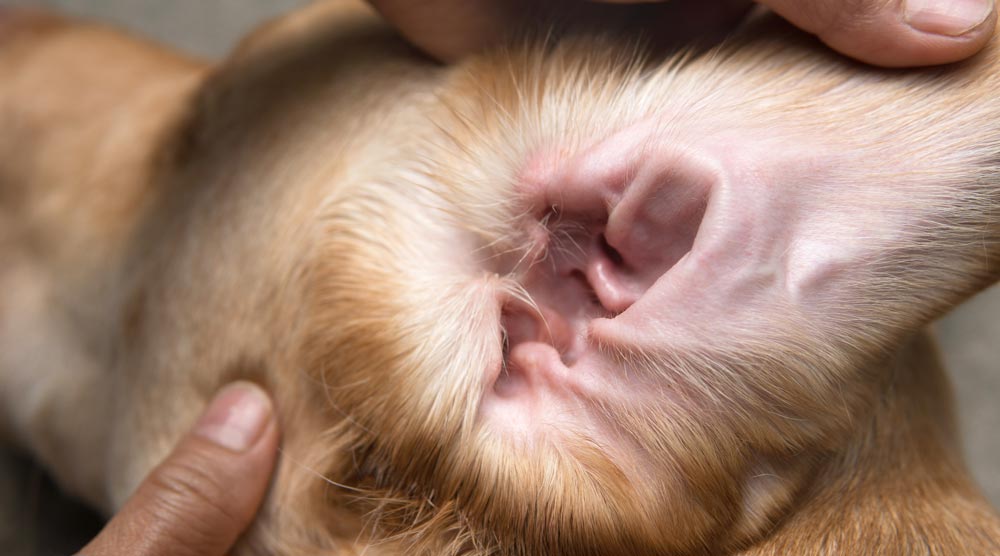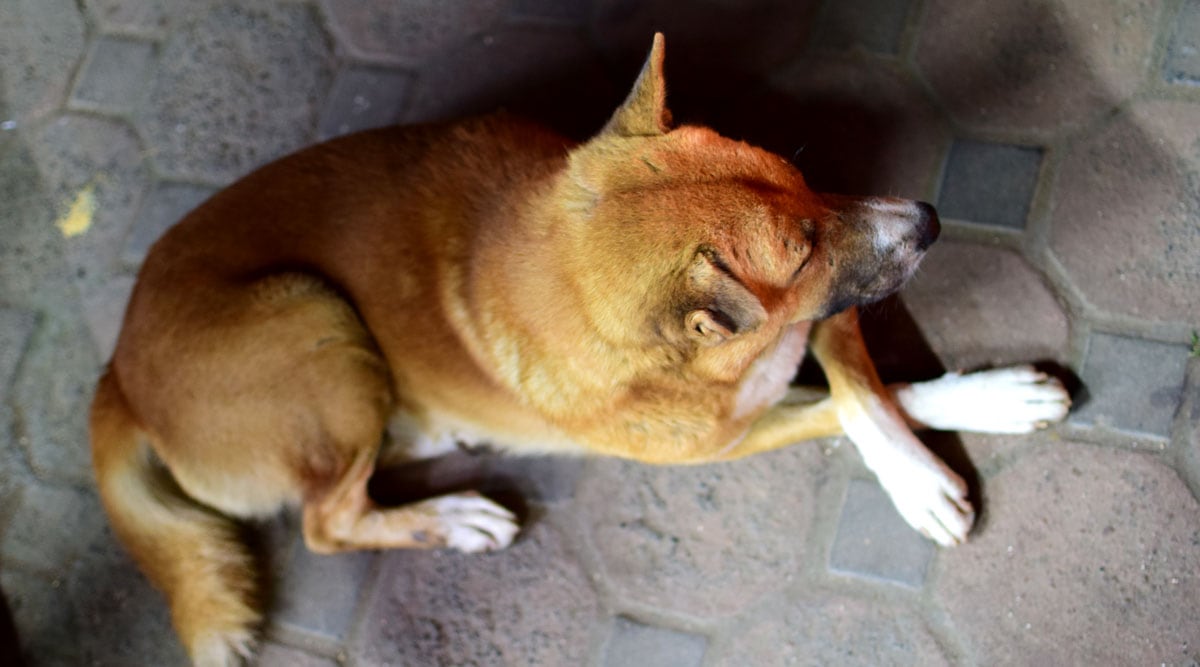Have you noticed black spots on your dog’s paw pads? If so, you’re probably wondering what’s causing them and whether they could indicate a medical issue.
Black spots are often a harmless part of the canine ageing process. Puppies are born with pink paw pads, but these thicken and darken as the dog walks on rough surfaces. Ageing spots, caused by pigment build-up, can also cause darker areas of skin as a dog enters its senior years.
However, black spots on the paw pads can sometimes indicate a health problem. For example, fungal and bacterial infections can cause discolouration on the paws. Small black lumps can also be a sign of skin cancer, so a vet checkup is essential if you notice new black spots on your dog’s paws.
Contents
A Quick Overview of Canine Paw Pads

It’s important for all dog owners to understand why healthy paw pads are essential for your dog’s quality of life.
Paw pads are leathery patches of skin near the dog’s toes. They are formed from several layers of tissue, with the top layer composed of tough keratinized skin. Below the top layers is also a fatty layer for added protection.
A dog’s paw pads are much more than just thickened skin. They provide a range of benefits, including:
- Traction on slippery surfaces
- Protection on rough terrain
- Protection against hot and cold surfaces (to a certain extent)
- Shock absorption due to the fatty layer
- More even weight distribution across the foot due to the fatty layer
- Sensory feedback to help the dog balance
For these reasons, it’s vital that a dog’s paw pads are healthy and undamaged. You should contact a vet if you notice any cuts, abrasions, lumps, or other changes to your dog’s pads.
How a Dog’s Paw Pads Develop
Paw pads begin developing in the womb. They are fully intact when a puppy is born, but are made from soft, pink skin that’s easily injured.
Walking on rough surfaces causes the puppy’s paw pads to thicken. During this time, new layers of dark skin build up to provide protection against rough surfaces and wider temperature ranges.
Paw pads don’t need to be completely dark though. Even when fully developed, it’s common for paw pads to be a mixture of black, pink, and tan.
Why Does My Dog Have a Black Spot On Their Paw?
1. Normal Aging Processes
As we mentioned earlier, puppies are born with pink paw pads. These toughen and thicken up during the first months of life, which causes them to change colour. The more time the puppy spends on rough surfaces, the faster this change happens.
Puppy paw pads don’t always uniformly darken. Some areas may get dark faster than others, giving the impression of black spots.
Additionally, older dogs may develop areas of darker skin that are similar to ageing spots in humans. While these usually occur on normal skin, it’s possible that they also happen on the paws.
Ageing spots are harmless. However, if you’re worried about the black patches on your dog’s paws, it’s best to get a vet checkup to be safe.
2. Genetics
The eventual colour of a dog’s paw pads varies depending on how much pigmentation is in the skin. This is linked to the dog’s genes, including their breed and coat colour.
Some paw pads are completely black, while others are tan or pink. It’s also common for a paw pad to contain a random mixture of these three colours.
In some cases, this can make the paw pads look like they have black spots. These patches are usually nothing to worry about if the dog has always had them though.
However, if you notice new black spots appearing on your adult dog’s paws, then you should always contact a vet. This is also why it’s important to regularly inspect your dog’s paws, so you can quickly identify when something has changed.
3. Dirt Stuck Between Paw Pads
If your dog has lightly coloured paw pads, then dirt stuck between the pads can sometimes give the appearance of black spots.
While this isn’t a sign of a medical condition, dirt build-up can cause infections and other problems if it isn’t removed.
The easiest way to clean a dog’s paws is in a bathtub or sink (depending on the dog’s size). Use warm water to wash away any dirt. If the dirt is particularly stubborn, you may need to add some canine shampoo to loosen it.
Always gently dry the paw pads with a towel after washing them.
Tip: Rinsing your dog’s paws after every walk is a good habit to develop. This removes dirt before it can build-up, while also reducing the chance of foreign objects getting stuck between the paw pads.
4. Fungal Infections
Fungal infections may cause blackened areas on the dog’s paw pads, especially if the infection is left untreated.
For example, yeast infections are a common health issue for dogs. They happen when a yeast called Malassezia pachydermatis penetrates the normal skin barrier, leading to fungal overgrowth.
A yeast infection can happen anywhere on a dog’s skin. But it’s most common in areas not covered by fur, such as paw pads or ear canals.
Symptoms of a yeast infection in the paw pads include:
- Itching
- Excessive paw licking
- Musty smell
- Crusty areas on the skin
- Redness including red paw pads
- Discharge
If left untreated, a yeast infection can cause areas of the paw pad to become darker and rougher. This can be difficult to spot in dogs with naturally dark paw pads, but is more obvious in dogs with tan or pink pads.
You should always contact a vet if you notice symptoms of a yeast infection. Treatment can involve topical medication, oral medication, or a combination of the two. Your vet can advise you on the right treatment depending on your dog’s age, health, and severity of the infection.
However, yeast infections are often secondary to other medical conditions, especially those that affect the immune system. If the infection is caused by an underlying health problem, then this will often need separate treatment.
5. Malignant Melanoma
Melanoma is a cancer that develops in cells that produce skin pigment. As pigment gives skin a darker colour, the tumours are often dark-coloured, which can give the appearance of a raised black spot.
This type of cancer can occur anywhere on the skin, but it’s most common on the feet (including paw pads) and around the mouth.
It’s important to contact your vet if you notice any lumps on your dog’s skin – even if they are small or are not black (including white spots on the paws). While most melanomas are dark, they can also lack pigment and appear pink. The only way to tell for sure is to get a biopsy.
Without treatment, a malignant melanoma will grow and spread to other body parts. The dog must have the melanoma surgically removed and undergo treatment to stop further spread.
The smaller the tumour when treatment begins, the better the outcome. So, don’t delay if you notice any lumps on your dog’s skin – seek veterinary advice immediately.

Other Paw Conditions That May Cause Black Spots
We’ve already mentioned the most common causes of black spots on a dog’s paws. However, other health conditions can potentially cause black spots, as they can affect the paws in unusual ways.
- Pododermatitis (inflammation of the paws). This is the general term used for an inflamed paw due to infection. It’s often accompanied by redness, swelling and pain. Inflammation can also lead to solid masses which may look black.
- Biting due to anxiety. An anxious or stressed dog may excessively bite their paws as a form of distraction. This can cause changes in the colour of the skin.
- Cuts or abrasions. A dog’s paw pads are tough, but they are not immune to cuts, burns, or abrasions. These may cause a dark scab during the healing process.
When Should You Contact a Vet About Black Spots on Paws?
In many cases, black spots on a dog’s paws are harmless and don’t need treatment. They are often a result of ageing, either due to a puppy’s pads thickening or pigmentation causing ageing spots.
However, you should always visit a vet if you notice new black spots, or if there are raised spots on the dog’s skin. You should also contact a vet if you notice other signs of a paw problem, such as:
- Limping
- Paw licking
- Paw biting
- Discharge
- Unpleasant smell
- Lesions
- Ulcers
- Inflammation of pinkness
- Bleeding
Treatment for black spots depends on what’s causing them. For example, if your dog has a fungal or bacterial infection, they’ll need medication to treat it. You shouldn’t try to treat paw problems at home, as the wrong approach could make the issue worse.
Summary
Puppies have pink paw pads when they are first born. These thicken and darken during the first six months of life. As the final colour of paw pads can be a mixture of black, tan, and pink, it can seem like the puppy has developed black spots.
However, black spots on the paw pads can be a sign of a health condition, such as a fungal infection or skin cancer. For this reason, it’s important to visit a vet if you notice new dark patches, raised lumps, or symptoms of discomfort in the paw.
Do you have any questions about black spots on a dog’s paw pads? Please let us know in the comments below.



